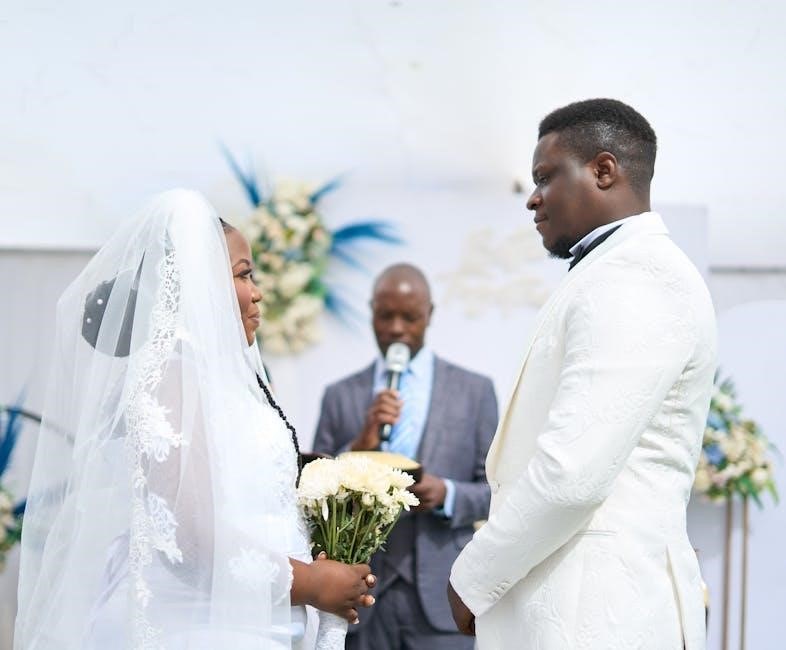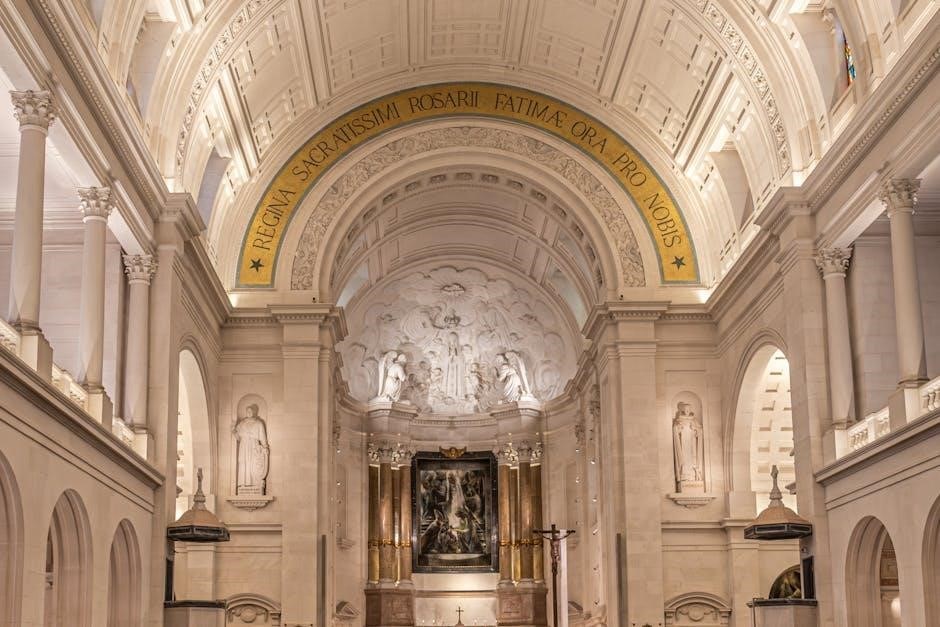The ceremonial of bishops holds profound significance in religious traditions, embodying centuries of spiritual and liturgical heritage․ It encompasses the rites, symbols, and practices that define episcopal ministry, serving as a bridge between history and contemporary worship․ The ceremonial of bishops PDF offers a comprehensive guide to understanding these sacred rituals, providing insights into the role of bishops as spiritual leaders and their impact on religious ceremonies and traditions worldwide․
1․1 Historical Background of Episcopal Ceremonial
The historical background of episcopal ceremonial traces back to early Christianity, where bishops emerged as prominent spiritual leaders․ Over centuries, the rituals surrounding their consecration and roles evolved, influenced by both liturgical traditions and cultural contexts․ The ceremonial of bishops PDF highlights early practices, such as the use of symbols like the mitre and crosier, which signified authority and shepherdship․ Historical texts reveal that by the Middle Ages, episcopal ceremonies had become highly formalized, reflecting the bishop’s central role in the Church․ The Second Vatican Council later brought reforms, modernizing these rituals while preserving their spiritual essence․ This rich history underscores the ceremonial’s enduring significance in religious life․
1․2 Significance of the Ceremonial in Religious Leadership
The ceremonial of bishops plays a vital role in emphasizing their spiritual and pastoral authority within the Church․ It serves as a visible expression of their divine mission, fostering reverence and unity among the faithful․ The rituals and symbols, such as the mitre and crozier, underscore the bishop’s role as a shepherd and leader․ This ceremonial also acts as a unifying force, binding the community to its traditions and fostering a shared religious identity․ By upholding these sacred practices, bishops embody the continuity of faith and guide their flock in worship and devotion, ensuring the ceremonial remains a cornerstone of religious leadership and inspiration․
The Consecration of Bishops
The consecration of bishops is a sacred rite marking their elevation to spiritual leadership․ Ceremonies, often lengthy and formal, affirm their divine mission and authority, ensuring continuity in faith․
2․1 The Rite of Episcopal Consecration
The rite of episcopal consecration is a solemn ceremony marking the elevation of a priest to the episcopacy․ It typically involves multiple bishops, known as co-consecrators, who jointly perform the sacred rites․ The ceremony begins with prayers and readings, followed by the laying on of hands, symbolizing the transmission of apostolic authority; The consecration is accompanied by anointing and the presentation of episcopal symbols, such as the mitre and crozier․ The rite is deeply rooted in tradition, emphasizing continuity and unity within the Church․ The ceremonial of bishops PDF provides detailed liturgical instructions, ensuring the rite’s integrity and theological richness․ This sacred act is central to the Church’s leadership and spiritual heritage․
2․2 Preparation for the Consecration Ceremony
Preparation for the episcopal consecration ceremony is a meticulous process involving both spiritual and liturgical elements․ The diocesan bishop oversees the arrangements, ensuring all rituals align with tradition and doctrine․ The candidate engages in prayer and reflection, while the congregation prepares through devotions and education․ Vestments, such as the amice, cope, and mitre, are carefully selected and readied․ Liturgical instruments, including the corporal and burse, are prepared for the altar․ The ceremonial of bishops PDF provides detailed guidance, ensuring every aspect of the preparation honors the sacred nature of the rite․ This thorough readiness underscores the ceremony’s significance in maintaining apostolic succession and spiritual leadership․

Liturgical Elements in the Ceremonial of Bishops
The Ceremonial of Bishops outlines essential liturgical elements, including vestments, instruments, and rituals, providing a structured framework for episcopal ceremonies as detailed in the ceremonial of bishops PDF․
3․1 Vestments and Regalia

Bishops’ vestments and regalia are integral to their liturgical identity, reflecting their spiritual authority and role․ The mitre, a tall, peaked headdress, symbolizes wisdom and leadership, while the crozier, or pastoral staff, represents their role as shepherds of the flock․ The pectoral cross, worn on the chest, signifies their devotion to Christ․ Other key items include the cope, a circular cape used in processions, and the dalmatic, a sleeved vestment worn during solemn ceremonies․ These garments are meticulously detailed in the ceremonial of bishops PDF, providing a comprehensive guide to their historical significance and proper use in liturgical settings․

3․2 The Use of Liturgical Instruments
Liturgical instruments play a vital role in the ceremonial of bishops, enhancing the sacred nature of religious rites․ The burse and corporal are essential, used to hold and prepare the Eucharistic bread during Mass․ The bishop also employs a ring, symbolizing fidelity to the Church, and a staff, representing pastoral authority․ Additionally, censers and aspersoria are used for incensation and blessings, while the mitre and crozier are carried in processions․ These instruments, detailed in the ceremonial of bishops PDF, are not merely symbolic but integral to the liturgical expression of episcopal ministry, connecting the bishop to centuries of tradition and spiritual practice․
3․3 Symbolism in Episcopal Ceremonial
Symbolism is deeply embedded in the ceremonial of bishops, conveying spiritual and theological truths․ The mitre symbolizes the bishop’s role as a teacher and spiritual leader, while the crozier represents pastoral care and guidance․ The ring signifies the bishop’s fidelity to the Church, and the staff embodies authority and shepherdship․ These symbols, as detailed in the ceremonial of bishops PDF, are not merely decorative but carry profound meaning, reflecting the bishop’s divine mission․ They also serve to connect the congregation to the sacred traditions of the Church, reinforcing the spiritual identity and heritage of the faith․

The Role of Bishops in Liturgical Celebrations
Bishops serve as chief liturgical officers, presiding over sacred rites and ensuring the faithful celebration of divine worship․ Their presence underscores the unity and sanctity of the Church․
4․1 The Bishop as the Chief Liturgical Officer
The bishop, as the chief liturgical officer, holds a central role in guiding and overseeing the liturgical life of the diocese․ Their authority extends to ensuring that all liturgical practices align with the traditions and decrees of the Church․ The bishop’s presence in major ceremonies, such as consecrations and ordinations, underscores their leadership and the unity of the Church․ They are responsible for setting liturgical standards, promoting devotion, and maintaining the integrity of religious practices․ Additionally, the bishop’s attire, including the mitre and crosier, symbolizes their office and spiritual authority․ Their role is not only to preside but also to inspire and lead the congregation in worship, ensuring that the liturgy reflects the deeper mysteries of the faith․
4․2 The Bishop’s Role in Processions and Ceremonies
The bishop plays a pivotal role in processions and ceremonies, often serving as the central figure who embodies the unity and tradition of the Church․ During processions, bishops are typically vested in cope and mitre, symbols of their office, and carry the crosier, representing their pastoral authority․ Their participation in ceremonies such as ordinations, consecrations, and solemn Masses underscores their spiritual leadership․ The bishop’s placement at the front of processions highlights their role as the shepherd guiding the flock; Additionally, their involvement in liturgical gestures, such as the sprinkling of holy water or the blessing of the congregation, reinforces their sacramental role․ These rituals, detailed in the ceremonial of bishops PDF, are essential for maintaining the rich tapestry of liturgical traditions and fostering a sense of communal worship․
Historical and Contemporary Practices
The ceremonial of bishops has evolved over centuries, shaped by councils like Vatican II, which modernized practices while preserving tradition․ The ceremonial of bishops PDF reflects this blend of historical roots and contemporary applications, serving as a model for liturgical celebrations today․
5․1 Evolution of Episcopal Ceremonial Over the Centuries

The ceremonial of bishops has undergone significant transformations over the centuries, reflecting changing liturgical practices and ecclesiastical norms․ Rooted in early Christian traditions, the rites were formalized during the Middle Ages, with the Vatican Councils and synods contributing to their development․ The Second Vatican Council introduced reforms, streamlining ceremonies while preserving their sacred essence․ Historical documents, such as the ceremonial of bishops PDF, reveal how these rituals have been adapted to align with contemporary worship needs․ From the use of mitres and croziers to the solemn processions, the evolution of episcopal ceremonial underscores a balance between tradition and modernization, ensuring its relevance in the Church’s mission today․
5․2 Modern Reforms and Their Impact on the Ceremonial
Modern reforms, particularly those emerging from the Second Vatican Council, have significantly influenced the ceremonial of bishops․ These reforms aimed to simplify and align liturgical practices with contemporary spiritual needs․ The revised ceremonial of bishops PDF reflects these changes, emphasizing clarity and active participation in liturgy․ Post-conciliar updates streamlined rituals, reducing elaborate gestures while retaining their symbolic richness․ This shift has fostered a greater sense of unity and accessibility within the Church․ The reforms also encouraged regional adaptations, ensuring the ceremonial remains relevant across diverse cultural contexts․ By balancing tradition with modernization, these changes have revitalized the role of bishops in liturgical celebrations, making their ceremonies more engaging and meaningful for today’s faithful․

The Ceremonial of Bishops in Different Christian Traditions
The ceremonial of bishops PDF highlights diverse practices across Catholic, Anglican, and Orthodox traditions, each preserving unique rituals, symbols, and vestments that reflect their distinct theological and cultural heritage․
6․1 Catholic, Anglican, and Orthodox Practices Compared
The ceremonial of bishops PDF reveals distinct practices across Catholic, Anglican, and Orthodox traditions․ Catholic bishops emphasize elaborate liturgical vestments, such as the mitre and crozier, symbolizing authority and pastoral care․ Anglican ceremonies, while similar, often reflect a more subdued approach, blending tradition with simplicity․ Orthodox bishops, meanwhile, incorporate rich iconography and chanting, emphasizing communal worship․ Each tradition uniquely balances liturgical rigor with cultural adaptation, as seen in the booklet for liturgical celebrations and the role of bishops as stewards of religious mysteries․ These comparisons highlight the shared symbolism of episcopal office, such as the ring and crosier, while showcasing divergent expressions rooted in historical and theological contexts;
6․2 Unique Aspects of Episcopal Ceremonial in Each Tradition

The ceremonial of bishops PDF highlights unique aspects of episcopal rituals across traditions․ In Catholic ceremonies, the bishop’s role as the spiritual leader is emphasized through the use of the crozier and mitre, symbolizing pastoral authority․ Anglican traditions often integrate local customs, creating a blend of simplicity and solemnity, as seen in processions where bishops wear the amice, cope, and mitre․ Orthodox ceremonies, rich in mysticism, emphasize communal participation, with chants and iconography central to the rites․ Each tradition’s ceremonial reflects its theological emphasis, such as the Catholic focus on sacramental authority or the Orthodox stress on liturgical mysticism, as noted in the consecration rites and liturgical guides․ These unique elements enrich the universal role of bishops in worship and leadership․
The Ceremonial of Bishops and Its Cultural Impact
The ceremonial of bishops PDF reveals its profound cultural impact, shaping religious identity through rituals and symbols while influencing art, architecture, and community traditions, bridging spirituality and heritage․
7․1 The Role of Ceremonial in Shaping Religious Identity
The ceremonial of bishops PDF highlights how episcopal rituals shape religious identity by embodying centuries of tradition and spiritual values․ These ceremonies, deeply rooted in history, provide a sense of continuity and connection to the faith’s heritage․ The consecration of bishops, as seen in St․ Patrick’s Cathedral, exemplifies how such events reinforce communal beliefs and practices․ The rituals also serve as a visual representation of religious authority, with bishops acting as spiritual leaders․ By adhering to these practices, religious communities strengthen their identity and foster unity among followers․ The ceremonial of bishops PDF underscores the importance of these rituals in inspiring devotion, loyalty, and a shared sense of purpose․
7․2 The Influence of Episcopal Ceremonial on Art and Architecture

The ceremonial of bishops PDF reveals the profound influence of episcopal rituals on art and architecture, particularly in cathedrals and places of worship․ The intricate details of bishop’s vestments, such as mitres and crosiers, often inspire architectural motifs and decorative elements․ The use of liturgical instruments, like the burse and corporal, reflects in the design of altars and sacred spaces․ Additionally, the processions and ceremonies involving bishops have shaped the layout of churches, emphasizing grandeur and symbolism․ This interplay between ritual and creativity highlights how episcopal ceremonial has inspired some of the most iconic religious art and architecture throughout history, as documented in the ceremonial of bishops PDF․

Resources and References
Key resources include the ceremonial of bishops PDF, detailing liturgical practices and traditions․ Online platforms offer free downloads of related texts, manuals, and historical documents for comprehensive study․
8․1 Key Texts and Documents on Episcopal Ceremonial
Essential texts include the Ceremonial of Bishops, revised by the Second Vatican Council, and historical documents like the Caeremoniale Episcoporum․ These resources provide detailed guidelines for episcopal rites, liturgical practices, and symbolic traditions․ Additionally, scholarly papers and booklets, such as those tracing the history of traditio instrumentorum, offer in-depth analysis of ordination rituals․ The ceremonial of bishops PDF is a widely accessible format for these documents, enabling global access to liturgical heritage․ Online libraries and ecclesiastical websites host these texts, serving as invaluable tools for clergy, scholars, and laity seeking to understand the rich tapestry of episcopal ceremonial traditions․
8․2 Online Platforms for Exploring Ceremonial of Bishops
Several online platforms offer extensive resources for exploring the ceremonial of bishops․ The internet’s largest free library provides access to downloadable PDFs of historical and contemporary documents․ Official church websites, such as those of Catholic dioceses and Anglican communes, often publish detailed guides and liturgical manuals․ Academic databases and theological websites also host scholarly articles and booklets on episcopal ceremonial traditions․ Additionally, platforms like the Vatican Library digitize rare texts, making them accessible to researchers and enthusiasts worldwide․ These resources collectively enhance understanding of the ceremonial practices and their significance in religious leadership and liturgy․